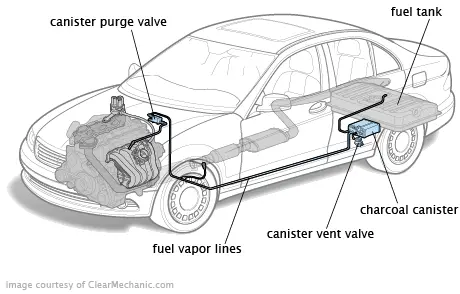Have you ever noticed how those orange gas cans swell up when they’ve got gas inside and the lid is on the tank? The reason that happens is because fuel vapors come off the fuel and accumulate inside the gas can. The same thing happens with the fuel inside your fuel tank! If you’ve been driving for a while, you’ve very likely seen an engine light come on because of an ‘’EVAP code’’. Today, we’re going to take a closer look at the EVAP system on modern day vehicles.
The automotive industry has seen considerable advancements over the years, not only in terms of performance and technology but also when it comes to environmental protections. A significant environmental development in modern vehicles is the Evaporative Emission Control System, commonly known as the EVAP system. The primary purpose of this system is to prevent the release of harmful fuel vapors into the atmosphere, thereby reducing air pollution and aiding in the fight against climate change.
What is the EVAP System?
The EVAP system is a network of components that work together to capture fuel vapors from the fuel tank and charcoal canister and deliver them to the engine to be burned off during the combustion process. By doing this, the system significantly reduces the amount of volatile organic compounds (VOCs) that escape into the atmosphere.
Key Components of the EVAP System:
- Gas Cap: A simple yet crucial part of the EVAP system is the gas cap, which seals the fuel system and prevents the emission of fuel vapors.
- Fuel Tank: This is where fuel is stored. The EVAP system begins here, capturing the vapors that build up inside.
- Purge Valve/Solenoid: This component controls the flow of the fuel vapors from the canister to the engine.
- Vent Control Valve: It regulates the pressure within the fuel tank by opening to vent air/vapors into the charcoal canister.
- Charcoal Canister: This canister stores the fuel vapors until the engine is ready to burn them. Activated charcoal inside the canister absorbs and stores the vapors.
- Fuel Tank Pressure Sensor: This sensor monitors the pressure within the fuel tank and sends the data to the vehicle’s computer system.

How Does the EVAP System Work?
The operation of the EVAP system can be broken down into a few stages:
- Vapor Collection: As the fuel vapors are produced in the fuel tank, they are temporarily held within the charcoal canister.
- System Monitoring: The fuel tank pressure sensor continually monitors the pressure within the tank and sends this information to the onboard computer (ECU).
- Purge Cycle: When conditions are optimal (usually when the vehicle is in operation and the engine has reached its operating temperature), the ECU opens the purge valve, allowing the trapped vapors to flow from the charcoal canister to the engine.
- Vapor Combustion: These vapors travel to the engine, where they are mixed with air and fuel, combusted within the engine’s cylinders, and finally emitted as exhaust gases after being treated by the vehicle’s emission control systems.
Importance of EVAP System Maintenance
Proper maintenance of the EVAP system is critical. A fault in the system can lead to a decrease in fuel efficiency, increased emissions, and potential damage to other components.
Signs of a faulty EVAP system include:
- The check engine light comes on
- Fuel odors emanate from the vehicle
- The engine may not run as smoothly
- Difficulty starting the engine
Routine inspections can help identify issues with EVAP components like cracked hoses, a loose gas cap, or a failing purge valve. Such issues are often diagnosed with the help of an OBD-II scanner, which can retrieve EVAP-related trouble codes from the vehicle’s computer.
The EVAP system represents a significant innovation in vehicular environmental and emissions technology. It reflects the automotive industry’s commitment to sustainability and responsibility, contributing to a cleaner environment. As vehicle owners and drivers, understanding your vehicle’s EVAP system is part of your responsibility to the environment. It is essential to ensure that this system is functioning correctly, both to meet emissions standards and to maintain the vehicle’s efficiency and longevity. Regular maintenance and prompt attention to any warning signs can keep this system operating effectively, helping to reduce our ecological footprint, one vehicle at a time.
